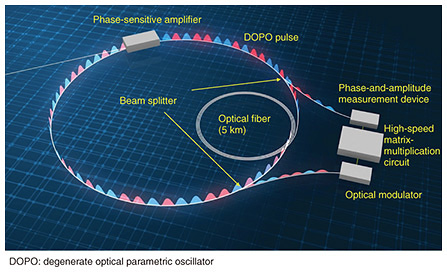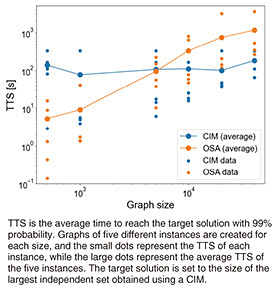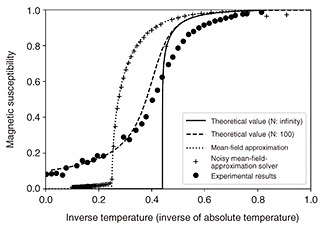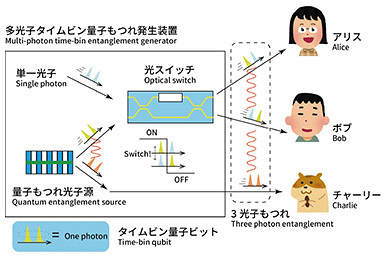 |
|||||||||||
|
|
|||||||||||
|
Front-line Researchers Vol. 23, No. 8, pp. 7–12, Aug. 2025. https://doi.org/10.53829/ntr202508fr1 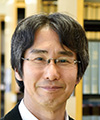 Moving Ising Machines Forward While Taking a Step towards Quantum Networks by Multi-photon Entangled States Based on Time-bin QubitsAbstractSolving a combinatorial optimization problem involves finding an optimal combination among a large number of options, and when the number of options becomes large, it becomes difficult to solve even with modern digital computers. We spoke with Hiroki Takesue, a senior distinguished researcher at NTT Basic Research Laboratories, who is exploring the “coherent Ising machine,” a photonic computer that uses a network of optical oscillators to solve a combinatorial optimization problem. He is also studying the “quantum internet” by creating the world’s first three-photon entangled state based on time-bin qubits. We asked him about his current efforts and thoughts on his research approach of working hard on site and getting outside once in a while. Keywords: coherent Ising machine, multi-photon entanglement, time-bin qubit Evaluating the performance of the coherent Ising machine in regard to solving problems directly related to applications while simulating the phase transition of a two-dimensional Ising model to understand the essence of a coherent Ising machine—Would you tell us about the research you are currently working on? My research is focused on two themes: the coherent Ising machine (CIM) and quantum communication using multi-photon entanglement. An Ising machine can be thought of as a physical simulator that simulates the Ising model. The Ising model is a theoretical model that describes the behavior of interacting spins. A spin is the angular momentum of a particle, which is a quantity that takes one of two values. It is known that many combinatorial optimization problems can be converted into problems to find the combination of spin values that minimizes energy in the Ising model. Accordingly, with physical experiments using an Ising machine, we can find the spin configuration that minimizes the energy; thus, we can obtain a solution to the target combinatorial optimization problem efficiently. In 2016, in collaboration with various research institutes participating in the Impulsing Paradigm Change Through Disruptive Technologies Program (ImPACT) of the Cabinet Office, we developed two CIMs that can execute stable and high-speed calculations of the Ising model by using the phase (0, π) of a special laser (called an optical parametric oscillator) to represent a spin (Fig. 1). In 2021, we reported that we had increased the number of spins of these CIMs from 2000 to 100,000 in Science Advances [1]. These achievements generated a significant response and were cited in many papers. They have led to various new Ising machines being proposed by many institutions around the world. I have been invited to give talks at many international conferences and have also been increasingly asked to serve as a committee member for international conferences and overseas journals. I hope that Ising machines will continue to be developed and become established as a new field. As pioneers in the field of Ising machines, we are pursuing research to evolve CIMs, and that research has recently produced two significant results.
One result concerns searching for solutions to problems involving the magnetic-field term. Although an increasing number of institutions are researching physical Ising machines, such as a CIM, the majority of physical Ising machines only solve problems without the magnetic-field term. The magnetic-field term is a term in the Ising model Hamiltonian that corresponds to an external magnetic field, which forces the orientation of each spin either to positive or negative. A problem without the magnetic-field term is a basic optimization problem that only involves the term representing interaction between spins. Since our team solved this basic problem in our first CIM experiments, many physical Ising machines of other research institutes have been evaluated using problems without the magnetic-field term. However, most real-world optimization problems are problems with the magnetic-field term, so for practical applications of CIMs, it is important to evaluate the performance of a CIM by using these problems. We proposed a method for implementing the magnetic-field term in a CIM by using some spins as auxiliary spins. We then used this method to search for a solution to the maximum-independent-set problem, one of the representative problems with a magnetic-field term, by using the CIM and optimized simulated annealing (OSA) implemented on a conventional digital computer. We generated graphs with numbers of nodes ranging from 500 to 40,000 and compared the average times to reach the target solution (TTS) by using OSA and the CIM (Fig. 2). According to the results in the figure, when the problem size was small, OSA was faster to obtain the target solution (shorter TTS); however, when the number of nodes was around 5000, the performances of OSA and the CIM were about the same. It is shown in the figure that for larger problem (graph) sizes, the CIM obtained the target solution faster than OSA, and the difference in TTS widened as problem (graph) size increased. These results were published in Science Advances (a sister journal of Science) in February 2025 [2]. I believe that by solving the problem with a magnetic-field term by using a CIM (namely a physical Ising machine), we have made a step forward in the entire research field of Ising machines.
My other research result concerns understanding the essence of a CIM. Immediately after we announced our CIMs in 2016, which couple optical parametric oscillators through measurement and feedback, a question was raised as to whether measurement and feedback is equivalent to mean-field approximation, which is an approximation method well known in statistical physics. The mean-field approximation reduces many-body problems, which take into account the interactions between many particles, to a one-body problem. In detail, the interactions of each particle with all other particles are considered an average effect, and instead of considering the interactions between individual particles (which are ignored), it is assumed that each particle behaves in an average “field.” While the mean-field approximation can simplify calculations for many-body problems, it generally reduces the accuracy of the calculations. While pondering ways to clarify the question “Isn’t a CIM a mean-field-approximation solver?”, I realized that all we needed to do was to simulate the phase transition of a two-dimensional Ising model on a CIM. As an important theoretical model, the exact solution of which was derived by Nobel Prize laureate Lars Onsager, the two-dimensional square-lattice Ising model is known to exhibit clear phase transitions. Interestingly, a mean-field-approximation solution of a two-dimensional Ising model is also well known, and the phase-transition temperature of the solution is clearly different from that of the exact solution. The results of an experiment using a CIM to reproduce the phase transition of the two-dimensional Ising model, as shown in Fig. 3, did not completely match the theory; however, we confirmed that the CIM clearly behaves closer to the exact solution rather than the mean-field approximation. I believe this result (shown in Fig. 3) strongly suggests that the CIM is not a mean-field-approximation solver but a physical simulator that simulates multi-body systems. These results were published in Physical Review Applied in March 2023 [3], and I believe we may have answered the question that had been posed to us.
Generating three-photon entangled states on the basis of time-bin quantum bits and contributing to the actualization of the quantum internet—“Quantum communication using multi-photon entanglement” is your new theme, correct? Since 2003, I have been researching quantum entanglement, which is a quantum state in which correlations exist between two or more particles that cannot be explained classically. Its existence was first discussed in a paper (which described the Einstein–Podolsky–Rosen paradox) by Einstein et al. in 1935, and quantum correlations have been researched extensively since then. In 2022, the Nobel Prize was awarded to Dr. Alain Aspect from France, Dr. John Clauser from the United States, and Dr. Anton Zeilinger from Austria for their experimental research on quantum entanglement. In 2004, under the guidance of my then supervisor, Professor Kyo Inoue (currently Professor Emeritus at Osaka University), I generated quantum entanglement of photons in the 1.5-µm wavelength band in an optical fiber [4]. This experiment was the world’s first to generate quantum entanglement in an optical fiber, which rivaled that of the Prem Kumar group at Northwestern University, marking the starting point of my research on quantum entanglement. Although my experiment involved quantum entanglement of two photons, Professor Zeilinger’s group, mentioned above, and others have advanced research into quantum entanglement of multiple photons, so it is now possible to generate quantum-entangled photon states of three or more photons. Most of these groups generated quantum-entanglement states related to the polarization state of photons. While polarization-based qubits are easy to control in free space, they are subject to disturbances caused by fluctuations in the refractive index of optical fibers and polarization-mode dispersion during transmission in optical fibers. Aiming for applications to quantum communication using optical fibers, we have been researching—and were the first in the world to achieve—three-photon entanglement based on time-bin qubits, which are stable quantum bits that use a superposition state with respect to the temporal position of photons (February 2023) [5]. For a multi-photon time-bin quantum-entanglement generator (Fig. 4), one of two quantum-entangled photons from an entangled photon source and a single photon are input into an optical switch to entangle the photons in a manner that generates a quantum-entangled state between three photons, which include the remaining entangled photon from the entangled photon source. The three photons generated in this way have the property that, although the results of measuring each photon are completely random, the measurement results of these photons exhibit a clear correlation. On the basis of this three-photon entanglement, for example, quantum cryptography—a type of absolutely secure encrypted communication based on the principles of quantum mechanics—between three parties (Alice, Bob, and Charlie) will be possible.
Starting in FY2023, we have been participating in the Ministry of Internal Affairs and Communications’ national project “Research and Development of Key Technologies for the Realization of a Quantum Internet,” and we will be pursuing research with the National Institute of Information and Communications Technology (NICT), Osaka University, Yokohama National University, Gakushuin University, and Tohoku University. The project will run until FY2027, and we hope to be able to demonstrate—as one of the project’s outcomes—a prototype of quantum communication using the above-described time-bin multi-photon entanglement. Memories of Dr. Sae Woo Nam—What do you keep in mind as a researcher? On a personal note, in January 2024, my friend and a former collaborator, Dr. Sae Woo Nam of the National Institute of Standards and Technology (NIST), passed away due to illness. Dr. Nam was a colleague with whom I conducted experiments on quantum cryptography when I was a visiting researcher in the laboratory of Professor Yoshihisa Yamamoto at Stanford University in the US (currently director of Physics & Informatics Laboratories at NTT Research, Inc.). He was the same generation as me (one year older), and although we sometimes had heated discussions (some might say arguments) in the lab late at night about how to conduct experiments, we produced several outstanding experimental results together, and we were able to publish them in Nature Photonics. A few years later, I became a visiting researcher at NIST and stayed in Boulder, USA, where we conducted experiments on quantum teleportation over the world’s longest optical fiber. After establishing the field of superconducting photon detectors, he went on to become one of the world’s leading researchers conducting quantum-information experiments of our generation. As well as giving me much knowledge and know-how about superconducting photon detectors, he also greatly influenced me in terms of his research style. First and foremost, Dr. Nam was a hard worker. He was a brilliant man who graduated from the Massachusetts Institute of Technology (MIT) and earned his doctorate from Stanford University, but he was also an engineer who was patient and proactive in doing tedious work like wiring superconducting devices inside refrigerators. Although he was already a group leader at NIST at the time I worked with him, he would not just leave it to his subordinates to carry out experiments; instead, he would take the initiative in conducting experiments himself in a manner that would guide his subordinates. Above all, he was consistent in his approach of actively interacting with collaborators from various backgrounds (as he did when he came to Stanford University for collaborative research) and making friends and conducting research with them in a way that strengthened himself as well as his team. I think he not only made his team but also his collaborators, myself included, stronger. He packed the superconducting photon detector that he had created into his car and visited many universities around the US, with whom he conducted collaborative research. Later, when he came to Japan, he brought the superconducting photon detector in his carry-on luggage! He was truly a researcher who got out there. I was greatly influenced by these styles of Dr. Sae Woo Nam. While I am a hard worker just like him, I was mostly experimenting alone. Watching him work, I became aware that sometimes getting outside and doing research can lead to achieving more-outstanding results and experiencing a wider world than ever before. Get outside once in a while—What is your message to younger researchers? I have been influenced by the research approaches of many researchers other than Dr. Sae Woo Nam, and each person’s research methods are truly different, so even if you can take inspiration from many people, in the end, you have no choice but to create your own way of doing things. However, if I could send just one message, it would be “Get outside once in a while.” By “outside,” I mean overseas, other groups and research institutions, other fields, or outside of your own existing framework. I have “gone outside” a number of times; for example, in 2003, I moved from NTT Access Network Service Systems Laboratories to NTT Basic Research Laboratories through an internal job posting and plunged into the world of quantum mechanics; in 2004, I stayed at Stanford University to conduct collaborative research with the Professor Yamamoto’s lab; and in 2015, I participated in the above-described CIM project. Each time, I plunged into new fields, met new people, and learned new things. Of course, I often feel confused in a new field, but I also often feel that my knowledge and skills are useful in a different field; above all, I feel like I have gained a new direction as a researcher. In a word, I urge you to work hard on site and get outside every once in a while. I hope this advice is helpful to everyone. References
■Interviewee profileHiroki Takesue received a B.E., M.E., and Ph.D. in engineering science from Osaka University in 1994, 1996, and 2002. In 1996, he joined NTT, where he was engaged in research on lightwave frequency synthesis, optical access networks using wavelength division multiplexing, and quantum optics. He is currently pursuing research on communication and computation using quantum optics technologies. He is the recipient of several awards, including the ITU-T Kaleidoscope Conference 2nd Best Paper Award in 2008, The Commendation for Science and Technology by the Minister of Education, Culture, Sports, Science and Technology of Japan (The Young Scientists’ Prize) in 2010, and the Nishina Memorial Prize in 2017. He was a visiting scholar at Stanford University, California, USA, from 2004 to 2005 and guest researcher at the National Institute of Standards and Technology (NIST), Colorado, USA, in 2014. He was selected as an Institute of Electrical and Electronics Engineers (IEEE) Photonics Society Distinguished Lecturer from July 2018 to June 2019. He is a guest professor in the Graduate School of Engineering Science, Osaka University and member of IEEE and the Japan Society of Applied Physics (JSAP). |
|||||||||||

